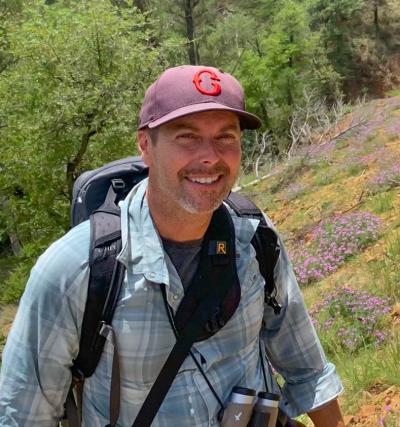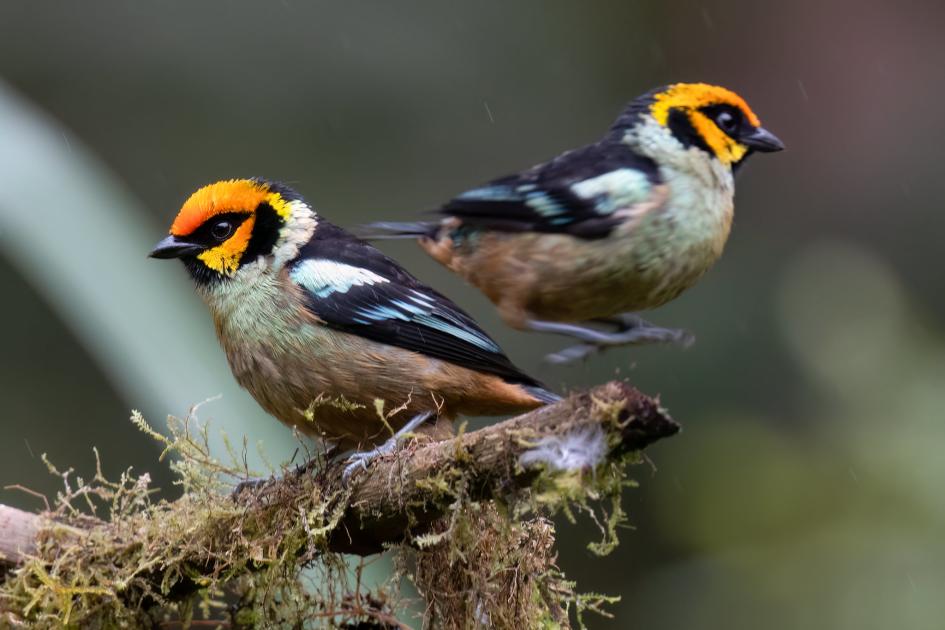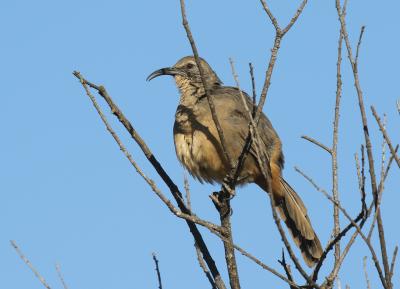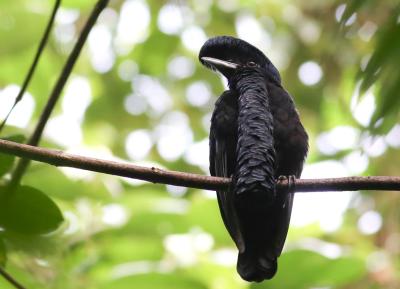Ecuador: Mindo and the Northwest Andes
-
Feb 1-9, 2026
Jon Feenstra
2026
Single Room Supplement $280
2026
Single Room Supplement $280
The Andes of western Ecuador have some of the best and most accessible birding locations in all of South America, and the wonderful Séptimo Paraíso Cloud Forest Reserve in Mindo is a prime example. While one-stop Ecuador tours will produce fewer species than a multi-week, all-country blitz, even a short tour based at a place like Séptimo Paraíso offers a superb combination of remarkable close-at-hand bird diversity and the inherent convenience of birding from a single comfortable base.
Séptimo Paraíso Lodge is comfortable indeed, with its own restaurant, spring-fed pool, spa, and support services. It is delightfully situated in the Mindo Valley and has great birding right on the grounds, as well as being an excellent base from which to explore surrounding areas. Among the birding localities we’ll visit, most of them along easily walked roads and trails, are the Tandayapa Valley, Mindo, the Paz de las Aves reserve, and the forest preserves at Milpe, Silanche, and Amagusa—all of them within 15 minutes to 1.5 hours from the lodge. During our seven days of birding we should encounter about 300 species, possibly including some of western Ecuador’s most celebrated: Giant Antpitta, Toucan Barbet, Plate-billed Mountain-Toucan, Ocellated Tapaculo, Andean Cock-of-the-rock, Rufous-tailed Jacamar, Club-winged Manakin, Indigo Flowerpiercer, Tanager Finch, and as many as 40 species of hummingbirds and 50 dazzling tanagers.
This tour can be taken in conjunction with our Ecuador: Eastern Andes to Amazon Lowlands tour.
Day 1: The tour begins at 6:30 p.m. in Puembo near Quito’s international airport. Night in Puembo.
Day 2: We’ll leave early for Yanacocha Reserve on the Pichincha Volcano. Located in temperate cloud forest, Yanacocha is home to a number of interesting high-elevation species. We’ll watch the hummingbird feeders for the amazing Sword-billed Hummingbird, Buff-winged Starfrontlet, and Great Sapphirewing. Tanagers are abundant, and we’ll hope to find mountain-tanagers such as Scarlet-bellied, Hooded, and possibly the rare Black-chested. We’ll then descend below the town of Nono through relatively untouched temperate and subtropical forest. Here we’ll look for White-capped Dipper, roadside mixed-species flocks, and perhaps a Torrent Duck or our first Andean Cock-of-the-rock, before arriving in late afternoon at Séptimo Paraíso Lodge, our home for the next six nights. Night at Séptimo Paraíso.
Days 3-7: We’ll have five full days to explore the many birding locations close to Séptimo Paraíso. The lodge is situated in a forested valley with a trail system right on the grounds. The first morning we’ll awake to the sounds of quetzals, motmots, numerous hummingbirds, and perhaps even the bizarre calls of a Wattled Guan, and then bird the grounds in search of tanagers, toucans, antpittas, and myriad other species. Another day we’ll visit the nearby Tandayapa Ridge and Tandayapa Valley, visiting hummingbird feeders in search of specialties such as Violet-tailed Sylph, Collared and Brown Incas, Purple-bibbed Whitetip, Fawn-breasted and Empress Brilliants, and Buff-tailed and Velvet-purple Coronets. Birding the flocks along the road can be exhilarating, and we’ll hope to connect with Plate-billed Mountain-Toucan and Toucan Barbet as well as Masked Trogon, Crimson-mantled Woodpecker, Turquoise Jay, Streaked Tuftedcheek, Streak-capped Treehunter, Plain-tailed Wren, Russet-crowned Warbler, many tanagers including Grass-green and Flame-faced, and perhaps even the very rare Tanager Finch (a fancy sparrow).
On one morning we’ll depart before dawn to visit a Cock-of-the-rock lek. The number of brilliant males attending the lek varies from day to day but the experience is never less than fascinating. If it can be arranged, we’ll also witness the now-famous local farmer Angel Paz feeding antpittas, possibly including Giant, Moustached, Ochre-breasted, and Yellow-breasted, and other species at his forest reserve. It’s truly an amazing spectacle! On other days we’ll drive to slightly lower elevations and encounter a host of different species, some widespread in the tropics, some at the southern end of their range, and some endemic to the Choco region of western Ecuador and adjacent Colombia. We’ll search for Blue-tailed Trogon, Purple-chested Hummingbird, Esmeraldas Antbird, Club-winged Manakin, Slate-throated Gnatcatcher, Choco Warbler, and many “new” tanagers including Moss-backed, Glistening-green, Gray-and-gold, Rufous-throated, Emerald, and Scarlet-browed. We could also encounter Fasciated Tiger-Heron, Rufous-tailed Jacamar, Orange-fronted Barbet, Red-billed Scythebill, the ethereal Black-tipped Cotinga, the diminutive Black-capped Pygmy-Tyrant, and the very local Indigo Flowerpiercer. Nights at Séptimo Paraíso.
Day 8: We’ll have much of today to look for anything special we may have missed. After lunch we’ll drive back toward Quito, perhaps stopping in the arid country above the city to search for a few species that we won’t have seen elsewhere, possibly including Ash-breasted Sierra-Finch, Band-tailed Seedeater, Golden Grosbeak, Tufted Tit-Tyrant, and Black-tailed Trainbearer. We’ll arrive at our Puembo hotel in the late afternoon in time to rest a bit before a delicious farewell dinner. Night in Puembo.
Day 9: The trip ends this morning in Puembo.
Note: The information presented below has been extracted from our formal General Information for this tour. It covers topics we feel potential registrants may wish to consider before booking space. The complete General Information for this tour will be sent to all tour registrants and of course, supplemental information, if needed, is available from the WINGS office.
ENTERING ECUADOR: Ecuadorian authorities require a passport that is valid for at least six months after the date of your arrival in Ecuador. Visas are currently not required for U.S. and Canadian citizens. Tourist cards are prepared by your arriving airline. There is a $40.80 departure tax in Ecuador, which is typically included in the price of your airline ticket, but have cash on hand in the event that it changes.
Proof of health insurance may be required when entering Ecuador. As of this writing, it hasn’t yet gone into effect, and the exact requirements are unclear. It’s probably best to have your insurance card or travel insurance confirmation with you on arrival. If for some reason your coverage doesn’t meet the requirement, we have been told that medical insurance can be purchased at the airport and that there are 2 or 3 companies stationed just outside of the baggage area. The basic insurance plans offered at the airport run about $35 for 30 days of coverage. The more comprehensive plans run somewhere around $95 for the same length of time.
Proof of a current Yellow Fever vaccination is required only if one is entering Ecuador directly from a country where the disease is endemic. Tourists entering Ecuador via transfer in Bogota or Panama have not been asked but it is best to be prepared in the event that changes.
It is always a good idea to take photocopies of your passport and air ticket with you when traveling abroad. They can prove invaluable in helping you get replacements if your original documents are lost or stolen. You should pack the photocopies separately from the originals. A good idea is to have digital photos of your documents emailed to yourself.
COUNTRY INFORMATION: You can review the U.S. Department of State Country Specific Travel Information here: https://travel.state.gov/content/travel.html and the CIA World Factbook here: https://www.cia.gov/the-world-factbook/. Review foreign travel advice from the UK government here: https://www.gov.uk/foreign-travel-advice and travel advice and advisories from the Government of Canada here: https://travel.gc.ca/travelling/advisories.
PACE OF THE TOUR: Daylight on the equator lasts only 12 hours and birds are most active in the early morning. Early starts are imperative, although these may be counteracted on some days by a post-lunch siesta or a couple of hours of free time before dinner. The majority of the birding will be done while walking slowly on dirt roads and along trails perhaps for a few hours at a time. Our vehicle and driver will be nearby at all locations if you need to leave anything in the vehicle during the days out. Bathroom facilities and running water are available at some of the reserves visited, but the presence of modern facilities should not be counted on during our birding days.
The conditions of the trails at the lodge and reserves vary. Some are flat, others are hilly, and many have carved earthen or wood-reinforced steps. When they’re dry, the trails are not difficult. When the trails are wet, they can be slippery and more difficult to negotiate. If we have a rainy period, the trails will be muddy and hill climbing may be difficult for the less agile. A collapsible walking stick is often useful.
On one morning there will be a pre-dawn hike to a Cock-of-the-Rock lek. The hike may be moderately difficult (about 5-10 minutes downhill, then back up), but we go slowly and the reward is well worth it!
On most days, we’ll be birding away from the lodge packing a box lunch, and returning in the late afternoon for dinner. There will be at least one optional after-dinner owling excursion.
HEALTH: The Centers for Disease Control and Prevention (CDC) recommends that you be up to date on routine vaccines before every trip. These vaccines include measles-mumps-rubella (MMR) vaccine, diphtheria-tetanus-pertussis vaccine, varicella (chickenpox) vaccine, polio vaccine, and your yearly flu shot. They further suggest most visitors also acquire protection for Hepatitis A and Typhoid.
Yellow Fever: The CDC recommends Yellow Fever protection for visitors traveling in rural Ecuador
Malaria: The CDC recommends Malaria protection for visitors traveling in Ecuador below 4900 feet (Séptimo Paraíso is at 4000 feet)
Please consult with your physician well in advance of your tour’s departure as some medications must be initiated weeks before the period of possible exposure.
The most current information about travelers’ health recommendations can be found on the CDC’s website here: https://wwwnc.cdc.gov/travel/destinations/list
Altitude: On the drive over the Andes from Quito, we will do some birding in the high-elevation paramo at around 12,000 feet. This is on the first full day of the tour, so arriving a day early is recommended if you want some extra time to acclimate to the altitude in Quito. Anyone with a history of altitude problems should discuss it with their physician.
Insects: Biting insects are a minor problem, and most areas are delightfully insect-free.
Smoking: Smoking is prohibited in the vehicles or when the group is gathered for meals, checklists, etc. If you are sharing a room with a nonsmoker, please do not smoke in the room. If you smoke in the field, do so well away and downwind from the group. If any location where the group is gathered has a stricter policy than the WINGS policy, that stricter policy will prevail.
Note: At Séptimo Paraíso smoking is prohibited inside any of the buildings.
CLIMATE: Quito has been called the city of eternal spring. There and in nearby Puembo where the tour begins, the climate is crisp and cool with chilly nights and pleasantly warm days. Rain is always possible, but sunburn is more likely. Séptimo Paraíso is situated at about 4,000 feet elevation and, for the most part, temperatures will be warm during the day (75 F, 24 C), and pleasantly cool at night (60-65 F, 15-18 C). The tour takes place during the region’s wet season, and periods of rain and/or fog are likely, especially later in the afternoon. The lower elevations will likely be hotter.
ACCOMMODATION: Séptimo Paraíso is a comfortable lodge situated near Mindo, one of the richest bird areas in western Ecuador. The lodge is beautiful, built in the style of many of the Monteverde (Costa Rica) hotels, with private bathrooms and rich, stained wood throughout. The lodge has an extensive trail system and hummingbird and fruit feeders.
Septimo has internet in its lounge, and when it’s working, it’s of moderate speed.
FOOD: Meals throughout are very good, with lots of vegetables, great soups, fruit juices, and various salads to accompany the fresh meat, chicken and fish. Vegetarians can be accommodated, but please let us know in advance.
TRANSPORTATION: We’ll use 9 to 15 passenger vans /buses depending on group size.
2025 Feb Narrative
Day 1: Today our birding as a group began earlier than scheduled, as everyone in the group had arrived a day early. Some spent the morning at Parque Nacional Antisana, seeking out high-elevation specialties, while others relaxed at our bird-friendly accommodation at Puembo Birding Garden until the tour began properly.
By 3 pm we had reconvened as a group at Puembo. Here we enjoyed localized specialties of this drier interandean valley, many of which would not be seen again for the rest of the trip as we descend into moist tropical and subtropical forests. The astounding density and diversity of habitats here in Ecuador means there are unique birds to find everywhere. No two sites are the same, even mere miles apart. At Puembo, Scrub Tanager (otherwise a near-endemic to Colombia’s central cordillera), Streak-throated Bush-Tyrant, and Croaking Ground Dove are particularly habitat-restricted in Northern Ecuador. A locally rare Merlin was also a highlight. Thunder and ominous clouds threatened from the surrounding mountainsides as we packed it in for the evening.
Day 2: Our first full day began with a 6 am breakfast before setting off for the almost 2-hour drive to Yanacocha. As we crossed the entire breadth of Quito, we got a feel for this massive city of almost 2 million.
At Yanacocha, we were greeted by atmospheric mist and clouds alongside a soundtrack of Undulated Antpitta, Ocellated Tapaculo, Blackish Tapaculo, and more. The mostly level, but rather lengthy, track out to the main hummingbird garden was tough work due to the over-11,000 ft elevation. Flurries of activity allowed us plenty of rest stops as we picked up Scarlet-bellied Mountain Tanagers, a Black-chested Mountain Tanager, Golden-crowned Tanagers, and a trio of Tawny-rumped, White-banded, and White-throated Tyrannulets. Several friendly-looking Equatorial Antpittas played hide and seek in the dense vegetation, eventually giving decent views to most of the group. Our destination, the hummingbird garden, made our effort worthwhile. Buff-winged Starfrontlets were joined by Golden-breasted and Sapphire-vented Pufflegs. Great Sapphirewings dwarfed the surrounding hummingbirds until the real star of the show arrived, the preposterously proportioned Sword-billed Hummingbird. Having put on a great show, it was time for us to head back to the reserve entrance, where lunch was waiting. After lunch, a Shining Sunbeam was an exciting final addition before we began the 2-and-a-half-hour drive to our home for the rest of the tour, Septimo Paraiso in Mindo.
Day 3: This morning we awoke in darkness, walking out of the lodge door at 6 to the sounds of Rufous Motmots and Ecuadorian Thrush. As the light increased, so did the chorus of birds from every direction. Two of the most exciting unfortunately remained out of sight, as we listened to the sweet notes of an Ecuadorian Seedeater buried deep in bamboo and a Scaled Fruiteater’s slurred whistles from the slope above; however, there remained much to see as hummingbirds swarmed the feeders, Choco Toucans put on a show over the driveway, and tanagers from Golden to Blue-necked moved through. It was tough to tear ourselves away for breakfast, and we were right back at it half an hour later. The remainder of the morning was a classic introduction to Mindo’s cloud forests. A remarkable 17 species of hummingbird made themselves known, from the outlandish White-booted Racket-tails and Violet-tailed Sylphs to the scarce White-throated Daggerbill. A stunning flash of red noisily cruising through the forest was our first Andean Cock-of-the-Rock. A pair of Red-headed Barbets, excellent views of Crested Guans feeding, and a female Golden-winged Manakin were all highlights alongside many more.
After a filling lunch, we made our way down into the town of Mindo. On the edge of town, a dirt road through some secondary habitat was our destination. Here we searched for the rare and recently split Coopman’s Elaenia. A pair eventually gave fantastic views, and we were otherwise entertained by a suite of new birds, including Scarlet-backed Woodpecker, Little Cuckoo, Pacific Hornero, a brief Masked Water-Tyrant, and many more. Several noisy White-throated Crakes remained stubbornly out of view. A quick check of the nearby river on the way back to the lodge produced a Torrent Tyrannulet as rain began to pour.
Day 4: An early start along a long and bumpy road immediately proved its worth as we stepped out in the dim predawn light at Bellavista Lodge. A moth light and fruit feeder combination in the lodge parking area kept us entranced for the following 3 hours. Turquoise Jays and Russet-crowned Warblers noisily surrounded us, but the real stars of the show were confiding and otherworldly Plate-billed Mountain-Toucans and a trio of White-faced Nunbirds. Streak-capped and Striped Treehunters made cameos, as did Barred Becard’s, Strong-billed Woodcreepers, Masked Trogons, and many more. Steps had to be taken with care, as Slate-throated Redstarts flitted around (and sometimes in between!) our feet. A good moth sheet in the neotropics is truly a revelation.
Once we finally dragged ourselves away from Bellavista we began to walk the surrounding roads. The forests here are in excellent condition and are a wonder in and of themselves. Despite lower-than-usual activity levels, we added a few new species and also found a Giant Earthworm measuring at least 3 feet long.
Next up was our lunch stop at the recently developed Guaycapi Lodge. We were greeted by sweeping views of montane forests shrouded in mist and possibly the most impressive feeders of the trip. Several Plate-billed Mountain-Toucans were joined by Crimson-rumped Toucanets, Red-headed Barbets, and a mind-numbing plague of tanagers. At times close to 50 individual tanagers must have been on the fruit platform, mostly Golden and Golden-naped. Some attempted late afternoon birding was somewhat curtailed by heavy rains.
Day 5: We ran into trouble early today. Having left at 5 am to arrive at Rio Silanche for dawn, we were confronted by an impassible river crossing just 4km from the reserve entrance. Continued heavy rain overnight meant water levels were exceptionally high. Scrambling for a new plan, we decided to instead to try some nearby habitat I had pinned as being of interest based on satellite imagery. This proved to be more successful than anticipated as we quickly found the near-endemic Rufous-headed Chachalaca, at the edge of their range here, followed by a calling Peruvian Pygmy-Owl. Collared Aracari’s visiting a nest in a tree cavity made for enjoyable viewing, as did pairs of Yellow-tailed Orioles and Black-faced Dacnis. Turning the corner we happened into a real star of the morning, the kookaburra-like Barred Puffbird. Dusky-faced Tanagers moved noisily through the underbrush.
Moving onto the next point of interest, we were delayed by a few interesting roadside birds, most notably a group of Ecuadorian Ground-Doves, also at the edge of their range here. The next stop consisted of some nice forest along a river edge. A group of Dot-winged Antwren’s were popular, as was a Blue-tailed Trogon. Walking up to the top of a rise, we decided to wait for a Gray-headed Kite flyover, which promptly arrived, albeit distantly. Just as we were ready to move on, a small brown bird flitted into a small tree over the road. Thinking it might be a new flycatcher for the trip, we tracked it down, instead finding a delightful Lanceolated Monklet. These tiny, rare puffbirds are always a treat and this one happily posed at close range for several minutes.
Our lunch stop at Sendero Frutti Tour had impressive feeder activity. Black-breasted Mango and Violet-bellied Hummingbirds were dwarfed by Lineated Woodpeckers. On the way back to the lodge we took a side track through some patches of Choco foothill rainforest, finding a White-bearded Manakin lek, a cooperative Collared Trogon, and hearing a White-whiskered Puffbird for a 3 puffbird species day.
Day 6: Today we visited the famous Reserva Paz de Las Aves of Antpitta fame. Always a highlight on any tour to the region, Rodrigo, Angel, and their family are deservedly celebrated as one of South America’s greatest ecotourism success stories. Their passion is impossible not to appreciate, and today was no exception. We began the day with lekking Andean Cock-of-the-Rock before moving on to our search for 4 antpitta species. Yellow-breasted and Chestnut-crowned were well-behaved and posed with little drama. Ochre-breasted was a favorite, this tiny “dancing” antpitta showing well despite the rain. Giant Antpitta is often the toughest here, and today was no exception. “Maria” and “Cariño”, the resident pair, are residing at the bottom of a fairly steep trail. Rodrigo worked hard to coax one of them out with no success despite an hour and a half of waiting. Not to be deterred, at the end of the morning he offered to look again and radio in the results of his search. Having found them, some of the group went down the trail for a second time while others waited at the feeders. Just as we approached the site, the rain began to fall heavily and the Giant Antpittas went back into hiding. We patiently waited as Rodrigo worked tirelessly to refind them. After another hour, we were getting ready to finally give up when Dana, trained on a cross-section of the understory, announced that he could see one. It wasn’t long before “Maria” was posing for us, a highlight of the trip for many, particularly given the effort expended.
Day 7: Reserva Amagusa is a personal favorite of mine. Unfortunately, it’s a fairly long (1.5 hour) drive from Mindo, and the moth sheet means early morning action is a must, thus requiring an early start. Thankfully, we were quickly repaid for our effort, and then some. A trio of Zeledon’s Antbirds hopped around beneath the sheet, Moss-backed and Glistening-green Tanagers posed at arm’s length, and a family of Dark-backed Wood-Quail visited the corn feeder; however, the real draw this morning was a fruiting tree behind the moth sheet. A collection of Black Solitaires, a striking Chocó endemic, Orange-breasted Fruiteaters, and Golden-winged Manakins feasted. This delightful selection was joined by the scarce and beautiful Scaled Fruiteater and a globally rare Rufous-brown Solitaire. Capping off a whirlwind morning was a walk along the entrance road. Amongst the mist, we added Indigo Flowerpiercer, Olive Finch, and Green-fronted Lancebill.
After Lunch, we continued to lower elevations beyond Amagusa. Here, we were treated by frantic activity at times, with highlights including Gray-and-Gold Tanager, Emerald Tanager, Guayaquil Woodpecker, Plumbeous Kites, and Orange-fronted Barbets.
Day 8: Our final day today, we began slightly later than the past few days, heading to the nearby Sachatamia Lodge in search of Long-wattled Umbrellabird. Having gathered in a hide overlooking a moth sheet and grape feeders we began our wait. A distinguished-looking Chestnut-capped Brushfinch was first to the sheet in the faint dawn light and was quickly followed by a flurry of activity which included Rufous Motmots, Spotted Barbtails, and Plain-brown Woodcreepers. Before long, a female Long-wattled Umbrellabird landed purposefully behind the feeder. We watched with excitement as she began devouring grapes. Not to be outdone, the male soon followed with his preposterous wattle dangling ungracefully as he swallowed grapes whole. We enjoyed the sheet for a while longer and were eventually treated to a grand finale of 3 Long-wattled Umbrellabirds just before we had to leave for breakfast. The male, a female, and a young bird interacted in what was perhaps the most memorable moment of the trip for many. The rest of the day was spent driving back towards Quito. We enjoyed a final pair of Plate-billed Mountain Toucans in pristine cloud forest towards Bellavista, and a trio of White-winged Tanagers delighted us during lunch. A stop in semi-desert at an abandoned horse track on the edge of Quito was surprisingly wet but produced Golden Grosbeaks, Ash-breasted Sierra Finch, and Blue-and-Yellow Tanagers. We arrived back at Puembo having enjoyed a fitting final day to top off a week of exciting birding and stunning scenery.
Jon does a great job. He makes sure everybody sees the birds. He's very friendly, professional, enthusiastic, and knowledgeable.
- Heidi J. on Ecuador: Mindo and the Northwest Andes
Excellent field ornithologist, good background information. Hard working, efficient and a thoroughly nice guy, excellent company , great sense of humour and the sort of guy you'd want as a friend irrespective of his birding abilities.
- Ian C. on Ecuador: Mindo and the Northwest Andes
Jon Feenstra is an excellent guide: professional, organized, caring and a good companion. The tour was well-conceived and organized, with a balanced program of walks and stationary observation. We saw a wide variety of birds, along with a few rarities. Very exciting.
- Angelo A. on Ecuador: Mindo and the Northwest Andes
Maximum group size eight participants with one leader.


































